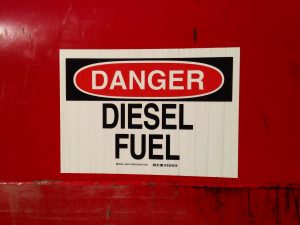Diesel fuel will always contain a certain percentage of water
The goal is to keep water levels within acceptable limits, well below the saturation point. Removing excessive water from fuel can be a challenge; therefore, the most effective approach is to take every reasonable measure to prevent water from entering your tank and monitor it regularly. This way the need for water removal can be kept to a minimum. In order to develop a good water management strategy, it is important to understand how to measure water content and evaluate the results.
 Measuring Water Content
Measuring Water Content
There are several methods for measuring water content in fuel. Some are done in a laboratory, some can be done on site. It is important to understand the type of information these different tests can provide. Perhaps the most common method for testing for water in fuel tanks is to “dip’’ the tank using a special indicator paste on a long dip stick. This method is fast, easy and can be done on site, it will tell you if there is free water in the tank bottom.
Water monitors (sensors) can be installed inline and give reliable real time results. They measure the dissolved water content in fuel and return the relative humidity of the diesel as a percentage. The maximum result is 100 percent, meaning that the fuel has reached its saturation point and can hold no more water in solution. This test method will not tell you how much free water there is in the tank.
Karl Fischer Titration Method
The Karl Fischer titration method is a laboratory test used since 1935 for determining water content in a fluid sample. The test is highly precise and requires only a small sample size. It detects even small amounts of dissolved water, down to about 50 parts per million (ppm) in diesel fuel. It can measure water content both below and above saturation level (dissolved and free water).
In laboratory practice it can be used to determine water saturation level of fuel under different conditions. While laboratory tests are typically more precise than field tests, they can be much less accurate. This may seem confusing. The reason that the laboratory test may be less accurate is that the sample itself may have changed between the time it was taken from the tank and the time it is tested in the lab.
One of the characteristics of diesel is that it holds more water in saturation when it is warm compared to when it is cold. If the diesel in your tank is cold, it may be over the saturation point. In this case there will be free water entering your equipment, which can cause huge problems. If you send this same sample to a lab, it will likely be warmer in the lab than in your tank. The fuel will warm up, the water will go back into solution, and it may look like you have no problem at all. The same sort of diagnosis difficulties can happen with ice crystal problems. The “evidence’’’ goes away at room temperature.
Enjoying our insights?
Subscribe to our newsletter to keep up with the latest industry trends and developments.
Stay InformedHow Much Water is Okay?
The easiest answer would be none. But this is neither practical nor realistic. All diesel contains some percentage of water. The most important thing is to keep the water below its saturation point so that it stays dissolved rather than entering your equipment as free water. Equipment manufacturers specify that zero free water must reach the engine. Saturation points vary from roughly 50 ppm to 1,800 ppm based on temperature and on the petroleum diesel/biodiesel ratio. Biodiesel can hold significantly more water in saturation than its petroleum equivalent. Blending biodiesel and petroleum diesel together, however, does not result in a mathematically proportional moisture content. The blend will hold less in solution that the sum of the parts, meaning that free water precipitation may occur when the two are mixed.
How To Prevent Free Water in Fuel
In order to understand how to keep water out, one must first understand how it gets in. Water can come from a wide variety of sources, some of which can be extremely difficult to control.
– On delivery from supplier:
Diesel is relatively clean and dry when it leaves the refinery, yet diesel deliveries will include variable amounts of water. The quantity of water you receive from your supplier depends largely on circumstance and handling practices. What can you control? Beyond potentially switching suppliers or negotiating a contract that puts the burden on the distributor, you can try the following:
(A) Be delivered first. You don’t want the water and contaminants that settle to the tank bottom.
(B) Install a water removal system at the inlet to your bulk tank.
– Ingress from atmosphere:
Just like the air, diesel has a relative humidity, and the two tend to equalize. Meaning, if the air is more humid than the fuel, then the fuel will absorb moisture from the air. If, however, the air is dryer than the fuel, then moisture will evaporate back up into the air until the relative humidity of both is equal.
– Free water fall-out:
Diesel holds a certain amount of water in solution (i.e. dissolved water). When water content goes over the saturation point, the excess water will fall out as free water. This occurs when the total water content increases or when the diesel cools. Your diesel may hold 90 ppm dissolved water when warm, but only 60 ppm when it cools down due to colder weather. The 30 ppm difference falls out as free water and settles to the bottom of the tank.
– Condensation in tank:
When it is warmer outside the tank than it is inside, condensation will form and this “sweat’’ will enter the fuel. This can occur over and over, creating more free water each time.
– Leakage into tank:
Rain, pressure washing or ground water can all be sources of water getting into a damaged or improperly sealed tank. In-ground tanks (at filling stations, for example) can sometimes have inlets below grade. The area around the cap can easily fill with rain water. If the water level is above the cap when removed, gravity will cause the water to flow right down into the tank.
Manufacturers publish filter efficiency based on the current industry test standards. The current standards were developed a number of years ago and are designed for lab comparison testing using a consistently treated fuel. This works well for comparison testing, but does not necessarily reflect filter efficiency in real world conditions.
So while you probably will not see a decrease in published coalescer efficiency levels, what you will notice in literature is the increased mention of water absorbers. Companies that still market coalescers to ULSD areas very frequently now mention the necessity of adding water absorbers after the coalescer. There is no other way to ensure that free water has been removed.
As explained earlier, the relative humidity of the diesel will tend toward the relative humidity of the air. Moisture in the diesel will, with time, be released back into the dry air until the diesel is just as dry as the air.
The key to good fuel water management is to minimize dissolved water content and eliminate all free water..
(This information was produced by Donaldson Filtration Solutions)






















